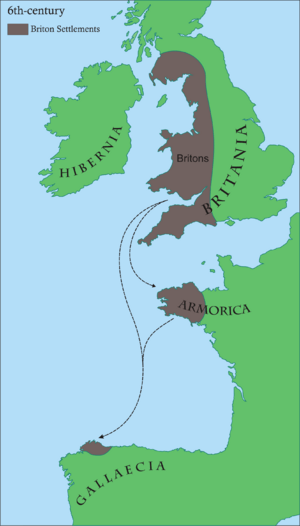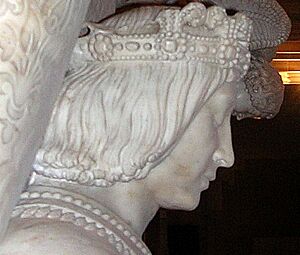History of Brittany facts for kids
Quick facts for kids
Brittany
|
|||
|---|---|---|---|
|
Historical province
|
|||
 |
|||
|
|||
| Motto(s): | |||
| Anthem: None (de jure) "Bro Gozh ma Zadoù" Old Land of Our Fathers (de facto) |
|||
 |
|||
| Country | France | ||
| Largest settlements | |||
| Area | |||
| • Total | 34,023 km2 (13,136 sq mi) | ||
| Population
(2021)
|
|||
| • Total | 4,829,968 | ||
| Demonym(s) | Bretons | ||
| Time zone | UTC+1 (CET) | ||
| • Summer (DST) | UTC+2 (CEST) | ||
| ISO 3166 code | FR-E | ||
Brittany is a region in France with a very long and interesting history. It's located on a peninsula, a piece of land surrounded by water on three sides. For a long time, Brittany was its own independent state.
Its story goes back to ancient times with huge stone monuments. Later, people from the British Isles moved there, bringing their culture and language. This led to the creation of the Duchy of Brittany, a powerful state that eventually joined France. Even after becoming part of France, Brittany kept its unique culture. Today, it's an important administrative region in France.
Contents
Exploring Brittany's Ancient Past
The history of Brittany starts thousands of years ago. People began settling here in prehistoric times.
Life in the Stone Age
The Stone Age in Brittany lasted a very long time. Early humans lived as hunter-gatherers. They used simple tools made from stone.
Early Human Traces
The oldest tools found in Brittany are about 700,000 to 10,000 years BC. They were found near the Vilaine river. People also lived in natural shelters along the coast, like in Carnac.
Some of the earliest evidence of fire use in Western Europe was found here. This was at a site called Menez Dregan, dating back 400,000 years BC.
The Middle Stone Age
The Mesolithic period was from 10,000 BC to 5000 BC. This was after the last Ice Age, when sea levels rose. Forests grew, and smaller animals like deer became common. People still hunted and gathered food. They also started fishing and collecting food from the sea.
Stone tools became smaller and more refined. People lived in more organized groups. Evidence from burial sites, like Téviec, shows some groups had special jobs. Sometimes, there were conflicts between different communities.
The New Stone Age and Megaliths
The Neolithic period (5000 BC to 2000 BC) brought big changes. People started farming and raising animals. They cleared land by burning forests. This led to economic growth.
This era is famous for its huge stone monuments called megaliths. These include burial mounds like the cairn of Barnenez, built around 5000 BC. These show a shared culture across the peninsula.
There are also tall standing stones called menhirs. The largest ever built was in Locmariaquer, standing 18.5 meters tall. These stones might have marked burials, helped with astronomy, or been part of religious practices. The last menhirs were put up around 1800-1500 BC.
Brittany's Early Tribes
Before the Romans arrived, different Celtic tribes lived in Brittany. These included the Veneti and the Namnetes.
Iron Age Discoveries
During the Iron Age, Brittany was rich in tin. This allowed people to make bronze objects. They traded these items with other parts of Europe.
Salt production was also very important, especially in northern Brittany. Sites like Ebihens had many salt ovens. This salt was traded widely.
Roman Rule in Armorica
In 56 BC, the Romans conquered the area under Julius Caesar. The Veneti tribe fought hard but were defeated. Their leaders were killed, and many people were sold as slaves.
The Romans called this region Armorica, which means "coastal region" in Celtic. It became part of the Roman province of Gallia Lugdunensis. The modern French department of Côtes-d'Armor still uses this ancient name.
During the 3rd century, there was unrest and some villages were destroyed. But under Emperor Constantine (307–350 AD), the region saw a comeback. New forts were built along the coast, for example, in Brest. Christianity also began to spread in the late 4th century.
Brittany in the Middle Ages
The Arrival of the Bretons
Around 380 AD, many Britons from the British Isles came to Armorica. Some were Roman soldiers. Later, more Britons came from places like Cornwall and Wales. They were trying to escape invading Anglo-Saxons.
These new settlers gave the region its current name, Brittany. They also brought the Breton language, which is similar to Welsh and Cornish. This is why Brittany was sometimes called Little Britain.
Many missionaries also came from Britain, like the seven founder-saints of Brittany. Many towns in Brittany are named after these early saints. The earliest known text in the Breton language is a botanical book from 590 AD.
Early Breton Kingdoms
In the Early Middle Ages, Brittany was divided into three small kingdoms: Domnonia, Cornouaille, and Bro Waroc'h. These kingdoms eventually joined together to form a larger Breton state. The first two kingdoms were named after the British homelands of the settlers. Bro Waroc'h was named after an early Breton ruler.
Fighting for Independence
During the 9th century, the Bretons fought to stay independent from the powerful Carolingian Empire of the Franks.
The Rise of the Duchy
The first unified Duchy of Brittany was created by Nominoe. In 845, the Breton army under Nominoe defeated the Franks at the Battle of Ballon. This gave Brittany control over important towns like Rennes and Nantes.
In 851, Nominoe's son, Erispoe, won another big battle at Battle of Jengland. After this, the Frankish king recognized Brittany's independence. This set the borders for the historic duchy. Later, under Salomon, the Bretons even teamed up with Vikings to defeat the Franks again in 866. This forced the Franks to confirm Brittany's independence and expand its territory.
However, the Vikings eventually turned on the Bretons and attacked Brittany. The Bretons had to fight back and, with help from the Franks, pushed the Vikings out. From then on, Brittany became a duchy, sometimes loyal to France, sometimes independent.
High Middle Ages and Conflicts
Bretons often resisted attempts by English kings to control their duchy. For example, Geoffroy II and his son Arthur fought against Henry II of England and King John.
In 1213, Philip August of France tried to strengthen his power in Brittany. He appointed Peter Mauclerc to manage the duchy. Peter Mauclerc introduced the use of ermines in the Breton coat of arms, which became a symbol of Brittany. He also worked to keep Brittany independent from France.
The War of Breton Succession
The Breton War of Succession was a long conflict from 1341 to 1364. It was part of the larger Hundred Years' War between England and France. Two families fought for control of Brittany: the Montforts (supported by England) and the Penthièvres (supported by France).
The war ended at the Battle of Auray in 1364, with the Montfort family winning. This led to a new rule about who could inherit the duchy. During this time, the États de Bretagne (Estates of Brittany) were formed in 1352. This group became the duchy's parliament.
In 1464, the Catholicon was published. This was a Breton-Latin-French dictionary, the first trilingual dictionary in the world.
The last independent Duke of Brittany, Francis II, was defeated by the French army in 1488. He was forced to sign a treaty. This treaty gave the King of France the right to decide who his daughter, Duchess Anne, would marry.
Duchess Anne was the last independent ruler. She eventually had to marry Louis XII of France. After her death, the duchy passed to her daughter, Claude. Claude's husband, Francis I of France, officially made Brittany part of the Kingdom of France in 1532. This was done through the Edict of Union between Brittany and France.
Brittany in Modern Times
Early Modern Period
After 1532, Brittany still had some special rights and its own institutions. These were defended by the Estates of Brittany. Brittany remained mostly Catholic during the time of religious wars in France.
In the 17th century, Brittany's ports grew thanks to France's growing navy. Major ports were built or improved in Saint-Malo, Brest, and Lorient. Many Bretons joined the French navy and helped with colonization in new lands.
In 1675, there was a rebellion called the Bonnets Rouges (Red Caps). People were upset about new taxes. The rebellion was put down, and many Bretons were punished.
In the 18th century, Nantes became one of France's most important trading centers. Its wealth came from a major trade route across the Atlantic.
The French Revolution's Impact
On August 4, 1789, the National Constituent Assembly in Paris ended feudal privileges. This meant Brittany lost its special rights and its own parliament.
Many Bretons did not like these changes. They especially disliked the anti-religious actions of the Revolution. Many joined the Chouannerie, a royalist uprising against the French Revolution. Brittany became a center of resistance.
In 1789, Brittany was divided into five new administrative areas called départements.
After the Revolution
In the 19th century, Brittany became known for its traditional way of life. People saw it as a place of old customs, religious festivals, and wild landscapes. However, Brittany also became more connected to the rest of France.
During the Franco-Prussian War, some French politicians worried about Breton soldiers. They feared Breton separatist feelings. Breton soldiers were sent to a military camp called Camp Conlie. Conditions were very bad, and many died from disease. This camp became a sad story in Breton nationalism.
Modern Breton nationalism began in the late 19th and early 20th centuries. After 1944, some Breton nationalists were criticized for working with the Nazis during World War II. However, other Breton nationalists joined the Resistance. Brittany played a big role in the Resistance because it was close to Great Britain and had important naval bases.
During World War II, many towns in Brittany, like Lorient, were heavily bombed by the Allies. This caused a lot of destruction and loss of life.
Modern Brittany and Its Culture
The official Brittany Region today includes four of the five traditional departments. The removal of Loire-Atlantique, which includes Nantes, has caused much debate.
In the 1960s, an experimental nuclear power station was built in Brennilis. It operated for about ten years and is now being taken apart.
Since the 1960s, the use of the Breton language has declined. Most children born after 1945 did not learn much Breton. However, there is growing support for the language among adults. The Diwan movement has created bilingual schools to help young people learn Breton. Breton music has also become more popular, thanks to artists like Alan Stivell.
In 1978, a supertanker called Amoco Cadiz spilled oil near the coast of Portsall. This was one of the largest oil spills ever and badly affected Brittany's northern coast.
In 1980, people in Plogoff protested against building a nuclear power plant in their town. They received wide support, and the project was eventually stopped.
In 2014, a group called the Bonnets Rouges protested against a new tax. They destroyed highway cameras and tax offices. Their actions led to the tax being cancelled.
See also
 In Spanish: Historia de Bretaña para niños
In Spanish: Historia de Bretaña para niños
- Breton literature
- List of Breton historians
- Viking Brittany





